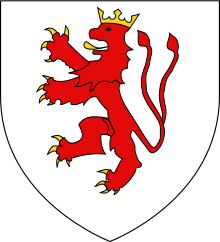Limburg lion
The Limburg or Limburger lion 's Heraldry an emblem and thus a Common FIG .
description
A red, double-tailed, gold-crowned, tongued and armored lion is depicted in silver .
It begins with Theodoric.
As the first gentleman at the new Hohen-Limburg Castle, he calls himself the Count of Limburg. He changes his inherited heraldic rose to the Limburg lion. The rose went down in history as the Isenburg rose . It is from the coat of arms of his father, whose rule ended in Isenburg ad Ruhr Castle, which was later partially destroyed. The decline of the castles Nienbrugge ad Lippe and Isenburg ad Ruhr was linked to the murder by Friedrich II of the Archbishop of Cologne, Engelbert . Later two lines of the house were formed: the Limburg and the Styrian.
In order to differentiate themselves from their Limburg parent company, the noble lords of Frenz, known as Frenzer, added the tournament collar to their coat of arms . In 1217 the heiress Irmgard von Berg was married to Duke Heinrich von Limburg . The Limburg Lion without a tournament collar with five bibs was probably already headed by Count Wilhelm (a son of Adolf VII ). This was related to the extinction of the Limburg line. The fourth generation of the Limburg line died around 1508 with Johann III. out. A union with Brabant ( Brabant Lion ) did not fail. The Limburg and Brabant lions can be identified on a Kerpen jury seal from 1306.
In a poem describing the origins of the lion it says:
“ … Irmengard looks beautiful from the bay window at Limburg's lion,
It is throbbing so quickly in the bosom of the fearful bride;
The lion, Limburg's coat of arms, shines on many a shield,
But she measures the rose on the helmets as fragrant, mild ... "
Assumptions about the two-tailed lion go back to the lion in the coat of arms of the Counts of Luxembourg and the dukes of the House of Limburg, who merged the two lords in 1214. It was meant to show a difference.
In 1226 Heinrich inherited the Duchy of Limburg / Maas. He added the red soaring Limburg lions in the silver field to the coat of arms of Bergen (two double-tinned red crossbars on silver) . The Counts of Berg initially had the double-tinned crossbar in their coat of arms. The coat of arms was borrowed from the Opladen city arms as a symbol of the castle.
The red Limburg lion can still be found in many coats of arms of the towns and communities in the Bergisches Land and is now referred to as the Bergischer Löwe . The Bergische Löwe is actually a Limburg lion by origin. The red, double-tailed Limburg lion in the silver coat of arms became the new heraldic animal of the new Bergisch headquarters. It became the new symbol for the Bergisches Land.
Today's coat of arms of the Belgian province of Limburg still shows the red, now gold-crowned, double-tailed, gold-armored lion in the silver field.
The lion is also shown in the coat of arms of the Iserlohn district , which was dissolved in 1975 .
- Examples
Limburg lion in the coat of arms of the Belgian province of Limburg
Limburg lion in the coat of arms of the Dutch province of Limburg
Also Kerkrade is a Limburg Lions
Limburg lion with tournament collar in the coat of arms of the city of Stolberg (Rhld.)
Above Brabant and below Limburg lion in the coat of arms of Kerpen
See also
Individual evidence
- ↑ Vincenz Jacob von Zuccalmaglio: The prehistory of the countries Cleve-Mark, Jülich-Berg and Westphalen. Friedrich Amberger publishing house, Solingen / Gummersbach 1837/1839/1870.
literature
- Christoph Jakob Kremer: Academic contributions to Gülch and Bergische history. Volume 2, Mannheim 1776.
- Ernst Heinrich Kneschke: New general German nobility lexicon. Volume 5, Friedrich Vogt, Leipzig 1864.





